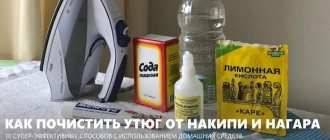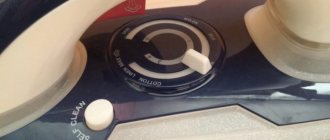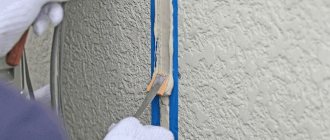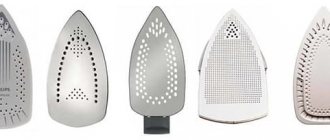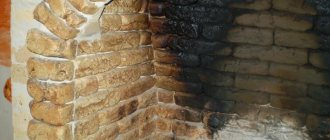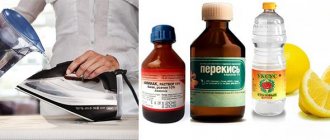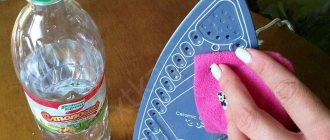Why does soot appear?
Brown plaque on the soleplate of the iron is formed due to the fact that:
- temperature standards for different types of fabric are violated: particles of clothing burn and stick to the iron;
- ironing plastic buttons and buttons;
- the water in the iron is too hard or contains a lot of chlorine: limescale first forms inside the device and then comes to the surface through the steam holes;
- The sole has scratches or cracks from falling or ironing metal elements.
Recipe 1: Clean the soleplate of the iron with salt
How to clean the soleplate of an iron with salt?
Ingredients:
- Salt.
- A blank sheet of paper or cardboard.
How to clean the soleplate of your iron with salt:
- Spread the salt in one layer on a clean sheet of paper or cardboard.
- Split the iron.
- Run the iron over the salt scattered on the sheet, pressing the soleplate firmly. The salt will remove all the carbon deposits from the surface.
Important! Please note that this recipe is not suitable if you need to clean the soleplate of a Teflon iron. Because Coarse salt can scratch it.
Types of soles and features of their cleaning
The cleaning method depends on the material from which the sole is made:
- Ceramics. Even minor damage can lead to peeling of the enamel, so you can clean such a surface with soft, non-abrasive agents and sponges. It is better to choose liquid formulations.
- Stainless steel. The material is very durable, so it can be cleaned by any means, including cleaning with abrasives.
- Titanium. The material is stronger than steel: it can be cleaned by any means. If the deposit is old and persistent, even a soft sponge made of metal wire will do.
- Aluminum. These soles are practical and inexpensive, but soft metal is easy to scratch. It is recommended to clean with mild cleaning agents, such as vinegar.
- Teflon. This material protects the metal sole of the iron from carbon deposits and rust, but it is very fragile and prone to scratches. Therefore, you need to handle Teflon carefully, using only liquid compounds for cleaning.
- Enamel. Easy to clean with a cloth soaked in water or a solution of laundry soap. If persistent carbon deposits form, it is permissible to use a soft metal sponge or a wooden spatula. You can use any home or store-bought products.
Material
Even when choosing an iron, you probably noticed that its sole can be made of different materials. We will not analyze the characteristics of each type, but will look at them from the point of view of the complexity of care and cleaning.
In any case, it is better to avoid coarse abrasives. For devices made of aluminum and stainless steel, exposure to small particles is still possible in exceptional cases (although they can leave unsightly scratches), but their use on ceramic and Teflon devices is absolutely unacceptable. Scratches can disrupt the operation of the unit and it will no longer perform its function well.
Therefore, first of all, try soft liquid formulations, and only if they do not help, use heavy artillery.
How to remove carbon deposits using home remedies
To make the iron sole smooth again, you can use products that are available in every home. Let's look at the most effective methods.
Acids
An acid solution will cope with carbon deposits on ceramics, Teflon or metal. Prepare a cleaner: mix a tablespoon of ammonia with the same volume of acetic acid. Dampen a cotton napkin or cloth with the liquid and rub the sole until the carbon deposits disappear. If it is heavily soiled, you can wipe the surface of the sole with the solution, cover with a cloth and wait until the dirt comes off.
Those who cannot stand the pungent smell of ammonia can mix vinegar with water in a ratio of two tablespoons per glass. The iron needs to be warmed up a little before cleaning.
Another method is suitable for Teflon soles. You need to wet the cloth with vinegar, lay it out on a hard surface, place a cold iron on top and leave it overnight. In the morning, wipe the iron with soapy water and rinse.
Baking soda
Soda in combination with nine percent table vinegar or clean water is also a good help in getting rid of carbon deposits. Two tablespoons are combined with acetic acid or water to form a thick paste. The iron is slightly heated. Soda slurry is applied to its surface using a cloth napkin. Rub contaminated areas carefully. Then wipe the surface with a clean, dry cloth.
Laundry soap
If carbon deposits have recently formed, then regular laundry soap will help:
- Grate the piece or plan it with a knife - you will need one tablespoon.
- Dissolve the shavings in a small amount of warm water to make a thick paste.
- Dampen a cloth or cellulose cloth with water and wipe the soleplate of the iron. Then wipe with a dry cloth.
- Heat the iron slightly.
- Now apply the soap solution to the ceramic or metal for 15-20 minutes. During this time, the sole will cool down and the soap will harden: wash it off using a damp sponge. The carbon deposits will be removed along with the soap.
Paraffin
A simple paraffin candle can help in cleaning metal and ceramics from stubborn carbon deposits. First you need to prepare: cover the surface where you plan to work with newspaper or place a metal tray. Wrap the candle in a towel to prevent it from slipping in your hand. Heat the iron to maximum temperature and rub the soleplate with the end of the candle.
Wait until the iron cools down and the paraffin hardens. Carefully remove the paraffin layer and wipe the cleaned surface with soapy water or a damp cloth. Make sure that there is not a drop of paraffin left on the soleplate and other parts of the iron, otherwise it will stain things during ironing.
Salt
This universal method is suitable for resistant surfaces. Salt is poured onto paper folded in several layers. Then heat the iron and “iron” the salt with it until the carbon deposits completely disappear.
There is a more gentle option that is suitable for ceramics and Teflon. A few tablespoons of salt are wrapped in cotton cloth to create a bag. They rub the sole of a heated iron with it, peeling off carbon deposits.
Hydrogen peroxide
This method will help get rid of fresh and old dirt. Take some cotton wool or a piece of cotton cloth and soak it in peroxide, then wipe all the dark spots on the surface of the sole. There is no need to heat the iron.
Ammonia will help enhance the effect. First, the sole is wiped with a cloth or cotton wool soaked in hydrogen peroxide, and then with a solution of five drops of ammonia and 100 ml of clean water. The procedure is repeated until the surface shines.
Toothpaste
Before using this method, please note: toothpaste often contains some abrasive particles, so it can only be used for ceramics, metal, and enamel. Such cleaning can damage Teflon.
The iron is slightly heated and the surface of the sole is lubricated with paste. Then rub the metal or ceramic surface with a soft cloth or brush until the carbon deposits disappear. The remaining paste is wiped off with a damp cloth soaked in clean water.
Method 3. Vinegar
Ordinary table vinegar will also help to clean the iron at home. Dilute it with filtered water in a ratio of 1 to 2, dampen a soft cotton cloth, heat the iron and, unplugging it, place it on a damp cloth. After 15-20 minutes, wipe the sole with a sponge.
If the dirt is serious, you can easily leave the iron unplugged on a cloth soaked in vinegar for several hours.
Ironing rules for beginners
How to clean an iron with special products
Cleaning Pencils
This method is suitable for ceramic, metal and Teflon soles and requires preliminary preparation. The cleaning pencil is sold in hardware stores, household chemical stores, and where household appliances—the irons themselves—are sold.
Please read the instructions carefully before using the pencil. Each manufacturer indicates to what temperature the soleplate of the iron must be heated before cleaning it. When it is hot, rub the tip of the pencil onto the dirty areas. Place a napkin under the iron to prevent dripping pencil from staining the surface on which the iron is placed. Wait a minute or two. Remove any remaining product with a dry cotton cloth.
Melamine sponge
A melamine sponge for cleaning dishes, gas stoves, and plumbing fixtures is also suitable for removing carbon deposits on an iron with metal, ceramic or Teflon soles.
Moisten the sponge with clean water and rub the dirty area. Then wipe the entire sole with a soft, dry cloth or paper towel.
Cleaning mat
Such a mat is placed on an ironing board and the sole of a cold iron with a metal or enamel sole is rubbed against it. At the end of the process, wipe the surface with a damp cloth, previously moistened with clean water.
Liquids
Sometimes the soleplate of the iron becomes dirty not only with carbon deposits. Particles of polyethylene or cellophane may stick to it. A solvent, such as acetone, will help get rid of them. You can use other liquid products with similar properties. Nail polish remover will do.
Take a cotton swab, linen or cotton cloth, and soak it in the liquid. And gently wipe the surface of the iron soleplate. When you remove the carbon deposits, wipe off the remaining solvent with a cloth soaked in clean warm water.
Method 5. Nail polish remover
A liquid with or without acetone is suitable. But when using this option to clean the iron, be careful: the liquid may damage the plastic parts. Therefore, it is best to apply the liquid pointwise, with a cotton swab or cotton pad. Simply rub the stain until it dissolves.
Life hack: making a template for ironing seam allowances
How to avoid carbon deposits
To avoid the appearance of carbon deposits, take care of it in advance.
about prevention. It is enough to follow the operating instructions: iron each type of fabric at the appropriate temperature. A maximum of +175° is suitable for cotton, up to +220° for linen, and no more than +120°C for silk. For items made of wool or synthetic fibers, it is recommended to use damp gauze.
In addition, only clean clothes should be ironed. Dirt particles can stick to the soleplate of the iron, causing carbon deposits to form. And one more tip: clean the soleplate after each use of the iron. Then it will always be clean.
Preventive measures
It would be useful to remind you how to prevent the formation of soot. The recommendations are obvious, but for some reason many people ignore them.
- Always follow the ironing temperatures indicated on the clothing label. This is especially true for synthetic and delicate fabrics. If for some reason the label has not been preserved, then there are hints on the iron mode switch.
- Iron thin materials, wool and silk through damp gauze.
- Never iron already worn, unwashed items. Dirt particles stick to the base and damage it.
- After ironing, wipe the surface with a cloth soaked in a weak solution of citric acid.
Prevention measures
To ensure that the iron lasts a long time and rust does not appear in the steam generator, you need to follow a few simple rules:
- It is advisable to fill the reservoir with distilled water or at least boiled water.
- To prevent rust, do not leave liquid in the internal reservoir. After turning off the iron, you need to evaporate all the steam.
- To prevent corrosion and clogging, the iron is placed vertically after ironing.
- Do not wrap the cord too tightly when the appliance is still hot.
- Steam supply is used only when necessary so that parts do not wear out ahead of time.
- Do not use metal brushes or sponges when cleaning the iron from rust.
And, of course, you should follow all the instructions specified in the instructions for the device. Proper care of equipment will extend its service life.
Video about cleaning the iron
The best way to prevent iron leakage is timely prevention. The appearance of a brown liquid indicates rusty parts inside the device or a melted silicone gasket. In this case, repair or complete replacement of the iron will be required. Any measures to clean the steam generator and the sole are effective if there is little rust.
Subscribe to TechnoCouncil on social networks so you don’t miss anything:
Cleaning the safety valve or anti-lime rod
To combat contamination of the interior, anti-lime rods are used. They are designed for water filtration. The mechanism for using such rods is as follows.
- It is located in the hole designed to supply steam to operate the iron.
- The rod is not inserted tightly, water flows, contaminating it.
- No replacement is required, but cleaning must be done periodically. It is performed monthly by removing the part and placing it in a special composition that contains 1 part water and 1 part vinegar, soda or citric acid.
- The duration of the cleaning procedure is 120 minutes. As a result, contaminants are completely dissolved.
- After finishing cleaning, rinse it with water, dry it and put it back in place.
Effective ways to clean a steam iron from scale inside
If this brand provides a self-cleaning system, then to get rid of the resulting contaminants you need to do the following:
- This electrical appliance has a water tank. You need to fill it in and turn on the iron. The heating level should be set to maximum.
- When it heats up to a certain degree, the thermostat will work and, as a result, the electrical appliance will be turned off. After this, you need to click to begin the self-cleaning procedure.
- A powerful jet of steam passing through the iron will wash away the scale.
- One procedure is probably not enough. For reliable and high-quality cleaning, it is necessary to perform it several times.
There are brands that have built-in protection. To perform the procedure in this situation, similar actions are taken. In this case, it is necessary to take into account the following features of such electrical appliances:
- Inside the body there is a cassette containing special substances in granules.
- When dissolved, they soften tap water. The mechanism of their action is that they act on the positive ions of magnesium and calcium, replacing them with negative ones.
Expert opinion
Sofia Kovalevskaya
Experienced housewife.
Ask me a question
Such granules can be installed once or permanently. There are brands of irons that can be replaced with new ones.
